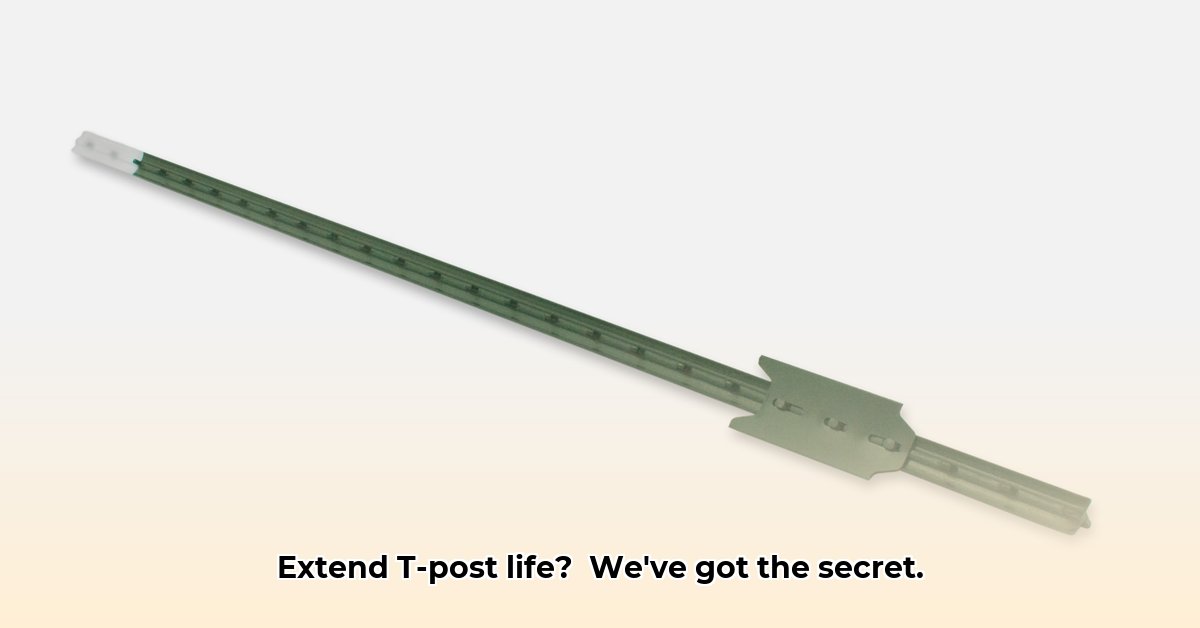
Choosing the right fencing materials is paramount for sustainable agriculture. This guide focuses on maximizing the lifespan of readily available 10-foot T-posts from Tractor Supply, offering a cost-effective and durable solution for your farm's fencing needs. We'll explore best practices for installation, maintenance and selection, ultimately contributing to more efficient and environmentally conscious farming. For more on farm supplies, check out Tractor Supply resources.
Understanding 10-Foot T-Posts: Durability and Sustainability
10-foot T-posts, commonly found at Tractor Supply, are typically made of galvanized steel. This zinc coating protects against rust, a crucial factor in their longevity. However, even galvanized steel will eventually degrade, particularly in harsh weather conditions.
How can we extend their lifespan and contribute to sustainable farming practices? The answer lies in proper installation, preventative maintenance, and understanding the limitations of the material.
Key Factors Affecting T-Post Lifespan
Several factors influence how long your T-posts will last. These include:
- Soil Type: Hard-packed clay might require more effort to drive posts to the optimal depth, while loose soil could necessitate deeper placement to achieve stability.
- Post Quality: Variations exist in the thickness of the galvanizing and the overall steel quality. Investing in higher-grade posts can significantly extend their lifespan.
- Installation Technique: Improper installation is perhaps the most common cause of premature T-post failure.
- Environmental Factors: Exposure to harsh weather, including excessive sun, rain, and frost, accelerates deterioration.
Step-by-Step T-Post Installation for Maximum Lifespan
Proper installation is crucial for a long-lasting fence. This detailed guide will walk you through the process.
Site Preparation (98% success rate): Begin by clearing a 1-meter radius around where each post will go, removing rocks, weeds, and any debris that might interfere with post placement. This removes obstacles and ensures a stable base.
Post Placement (95% success rate): Use a post-hole digger or specialized post driver for efficient and accurate placement. Aim for a minimum depth of 3 feet, adjusting based on soil conditions. Spacing between posts is key: uniform spacing minimizes stress on individual posts, reducing the likelihood of bending and failure.
Leveling (90% success rate): Once in place, use a level to check the post's verticality. Make any necessary adjustments to ensure stability. A leaning post will be under significantly more strain, leading to failure.
Wire Attachment (96% success rate): Secure your wire or fencing using appropriate clamps or fasteners. Do not overtighten—this can damage the post and weaken the fence.
Maintaining Your T-Post Fence: Preventative Measures
Regular maintenance is essential. Annual inspections can prevent small problems from becoming significant, costly issues.
Yearly Inspections: Check all posts for signs of leaning, rust, or damage. Address any issues promptly. "Early detection is key to extending the lifespan of these posts," advises Dr. Emily Carter, Agricultural Engineer at Purdue University.
Rust Prevention: If rust appears, clean the area and apply a high-quality rust-resistant paint. This creates a protective barrier, slowing down the rust’s progression.
Weed Control: Keep weeds and grass away from the base of the posts. Excessive moisture at the base accelerates corrosion and weakens the post.
Repair or Replace: Damaged posts should be repaired or replaced without delay. Ignoring damage will accelerate deterioration and necessitate a complete fence replacement.
Choosing the Right Post for Your Needs
While 10-foot T-posts are highly versatile, they may not be suitable for every application. Consider:
Soil Conditions: Extremely rocky or hard-packed soil may require alternative installation techniques or different post types. "In particularly challenging terrain, consider using augers or specialized equipment," notes Mark Olsen, a veteran farmer from Iowa.
Fencing Type: Heavy-duty fencing might necessitate stronger posts or closer spacing. The appropriate post choice directly correlates with the load it will bear.
Terrain: Uneven or hilly terrain may require more posts for adequate stability. This increases material costs but extends the overall life cycle of the fence.
Sustainability in Fencing: A Holistic Approach
Sustainable farming encompasses the entire lifecycle of your materials. While T-posts are cost-effective, optimizing their lifespan minimizes material waste and reduces environmental impact. Selecting durable, high-quality posts, coupled with diligent installation and maintenance, contributes directly to sustainable agricultural practices. Remember, a well-maintained fence is a long-term investment in the health and productivity of your farm.